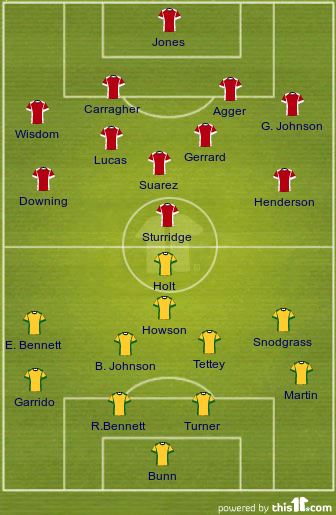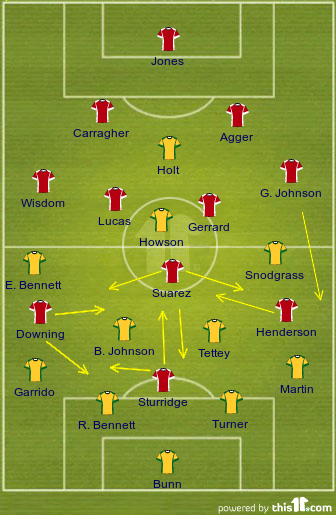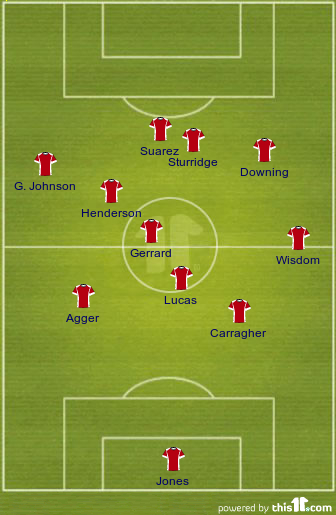After the disappointing result at Old Trafford where Liverpool’s timid first-half tactics and cautious team selection cost them the match, Brendan Rodgers and his side made amends in spectacular fashion at Anfield. Liverpool outclassed Norwich City in a performance that was worthy of the club’s stature, thereby completing an emphatic double over the hapless Canaries who have now conceded 10 (25%) of the Reds’ 40 league goals this season.
The circumstances leading up to the match, for both Liverpool (suffering a 2-1 defeat to United a few days prior) and Norwich (in the midst of a mediocre run), were identical to the reverse fixture in September. Unfortunately for Norwich, so was the manner of defeat – five goals were conceded, Luis Suarez ran the show and manager Chris Hughton lamented their defensive display against a “very good and clinical side”.
Incidentally, it was a five-goal defeat to this very opposition at Carrow Road that stunned Norwich into a wonderful unbeaten run – one that was only matched by Barcelona at the time – and Hughton will be hoping for a case of déjà vu.
Line-ups
Brendan Rodgers gave a maiden start to the partnership of Luis Suarez and Daniel Sturridge, with the latter replacing Raheem Sterling in the starting eleven, while Jordan Henderson replaced Joe Allen in midfield. Liverpool’s line-up posed intriguing questions on how they were likely to shape up – which striker will play as a wide forward? Will Henderson take up the left midfield slot? Will presence of two strikers and three central midfielders in the same team affect Suarez’s game?

Chris Hughton, on the other hand, decided to bench his most creative and crafty attacking midfielder Wesley Hoolahan in favour of central midfielder Jonathan Howson to counter Liverpool’s midfield trio. The away side were set up in their usual 4-4-1-1 but largely to defend and hope that they nick a goal through a set piece (which they nearly did in the opening exchanges of the match).
Match analysis
The match turned out to be an extremely one-sided affair, mirroring the statistics from the sides’ previous meeting. Liverpool dominated possession with 67.7%, producing 19 shots and attempting a mammoth 694 passes (accuracy 90%) at Anfield. The same figures read 67.1%, 17 shots and 700 passes (accuracy 90%) in the reverse fixture.
There were two key reasons for the failure of Hughton’s game plan. First, Norwich chose not to press Liverpool’s deep-lying midfielders. And second, Liverpool’s incredible movement allowed them to overload the centre of midfield without actually skewing the shape of the team.
Norwich’s choice not to press
The lack of pressing on Norwich’s part was understandable considering the pace of Liverpool’s front players. To press high up the pitch means to collectively move up as a team, where the chance of exposing either the space in behind the defence or the space between the backline and midfield is high. Only a well-drilled unit, with confidence in its defence, holds the ability to execute such a plan but it is a plan that Liverpool have recently struggled with.
Both Stoke City and Manchester United chose to press aggressively high up the pitch to put the Reds off their passing game and got positive results. Even Aston Villa, although camped in their own half for the majority of their triumph at Anfield, pressed with two strikers to force Liverpool to go through the sides rather than through the centre.
All but one of Norwich’s 21 tackles (17 successful) were attempted in their own half. All but 4 tackles were attempted in Liverpool’s attacking third. 48% of the tackles were made in and around their own penalty box and, quite ironically, the ball from one of those tackles on Suarez bounced up nicely for Henderson to volley in the opening goal. That goal was crucial in opening the proverbial floodgates.
Compare this to the treatment dished out to Liverpool at Stoke City, when 16 of the 26 tackles were attempted in either the middle third of the pitch or Liverpool’s defensive third. Consequently, Liverpool’s passing accuracy against Stoke was 84% overall (6% less than against Norwich) and 76% in the final third (7% less). Of course, the above comparison is made between a home and an away match, but Liverpool had 62% possession at the Britannia; only for their dominance to be in non-threatening areas due to the opposition’s plan.
Norwich’s strategy played into the hands of Steven Gerrard who thrives when given the freedom to pick out a pass and struggles when forced to do so under pressure. The talismanic skipper, who has played every minute of his club’s league campaign thus far, finished the game with 115 passes (93% accuracy). He also attempted 23 long balls, succeeding with 20 of them. Most tellingly, 60% of his passes were made in the attacking half and nearly a third of the passes were made in the attacking third.
Other highest passers in the match were centre-backs Jamie Carragher and Daniel Agger and defensive midfielder Lucas Leiva with 78, 76 and 67 passes respectively. The fact that a massive 41% of the passes made by these three players were made in the attacking half gives you an indication of how deep Norwich were camped in their own half.
Liverpool’s dynamic movement
As early as the sixth minute of the match, Stewart Downing made a central run in behind the defence from wide right, picked out by Gerrard. The move did not lead to a chance but it was an indicator of things to come.
If Norwich hadn’t pre-decided to sit as deep as they eventually did, the early exchanges must have made their mindset to do so. They were gradually forced deeper and deeper throughout the match. In fact, when Norwich tried to push up a bit, it led to a goal through one pass from back to front. That goal was aided of course by a wonderful dummy from Sturridge, who had attracted the attention of two Norwich players which in turn freed up Suarez to run into acres of space and score.
Chris Hughton’s side once again failed to counter the threat of Suarez, who had been their tormentor-in-chief on the previous two occasions. Norwich’s plans to focus their attention on the Uruguayan and track his runs were completely foiled by Liverpool’s synchronized movement and the fact that he had another striker, in Sturridge, to threaten in and around the Canaries’ penalty area.

The wonderful aspect of keeping possession of the ball for 68% of the match is that you don’t necessarily need to abide by a particular formation when you attack. And this is exactly what Liverpool took advantage of.
The pair-wise movements of Liverpool’s front men were extraordinarily brilliant and hard to keep track of. When Downing roamed inside, Sturridge would move towards the right and Suarez would choose go up top depending on Downing’s final position.
Henderson and Suarez took turns to drift towards the left. Sturridge and Suarez would often switch places but the latter largely played behind the former. The two strikers also dropped deep into the midfield on some occasions, which then automatically triggered a forward run from Gerrard. Such transitions were fast and seamless and shattered Norwich’s hopes of settling down.
Liverpool’s central overload
If Hughton was hoping to cramp the space in the centre to suffocate the home side, Liverpool’s reply to it was to overload it even further and rely on quick passes and trickery around the box. Henderson and Suarez (as their average positions indicate) were largely central even though they had the shared responsibility of manning Liverpool’s left wing.

This was possible because of the presence of Glen Johnson, whose significance as an adventurous attacking full-back came to the fore in the match. During his team’s attacking forays, Johnson was practically playing in the left wing position allowing Henderson and Suarez to play around Norwich’s two holding midfielders. His average position in the match (as shown above) was higher than Henderson and nearly as advanced as Downing on the opposite flank.
Even Andre Wisdom had stationed himself high up the pitch when Liverpool hogged possession but due to the young right-back’s limited attacking capabilities, he wasn’t as threatening an outlet as Johnson.
When Liverpool defended, Henderson smartly occupied the left flank and Suarez maintained his position in the centre. Norwich’s slow transition from defence to attack and lack of numbers in forward areas meant that they were never in a position to quickly exploit Liverpool’s skewed formations.
Whereas the likes of Aston Villa, with Andreas Weimann and Christian Benteke, and Stoke City, with Jonathan Walters and Kenwyne Jones, had two strikers to immediately transition from defence to attack, Howson and Holt provided no such threat to the opposition.
Match conclusion
Liverpool had too much quality for a very defensive Norwich City. There were fears that the impact of Sturridge could be negative on Suarez in the sense that it will drive the Uruguayan further away from goal. However, early indications are that it may turn out to be a quality partnership that gives Suarez more freedom to express himself on the pitch.
The home side’s collective movement on the pitch was far too impressive for this specific set of players not to start more games together. While Hughton will simply hope to forget the game and start afresh, Rodgers will learn whether his players can keep up such a performance in tough away matches when they travel to Arsenal and Manchester City in the space of four days next week.

